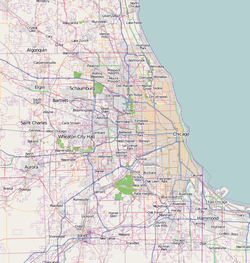| Wingert House | |
|---|---|
 Front view of Wingert House in Norwood Park West, Chicago, IL | |
| Type | Building |
| Location | 6231 N. Canfield Ave. Chicago, Illinois, United States |
| Coordinates | 41°59′39″N87°49′18″W / 41.9943°N 87.8218°W |
| Built | 1854; Additions, 1865–1875 |
| Built for | John Wingert |
| Original use | Farmhouse |
| Architectural style | Italianate |
| Official name | Wingert House |
| Type | Building |
| Designated | 31 July 1990 |
The Wingert House is a nineteenth-century farmhouse located at 6231 North Canfield Avenue in the Norwood Park neighborhood of Chicago, Illinois, United States. One of the oldest surviving farmhouses within Chicago's city limits, the building received Chicago Landmark status on July 31, 1990. [1] [2]
Contents
The house was built in 1854 as the home of John Wingert, a German immigrant who had fled his home country due to religious persecution. A two-story Italianate style section was added between 1868 and 1875. [1] The Wingert House is one of the few extant buildings in Chicago that predate the Great Fire of 1871. [3]


